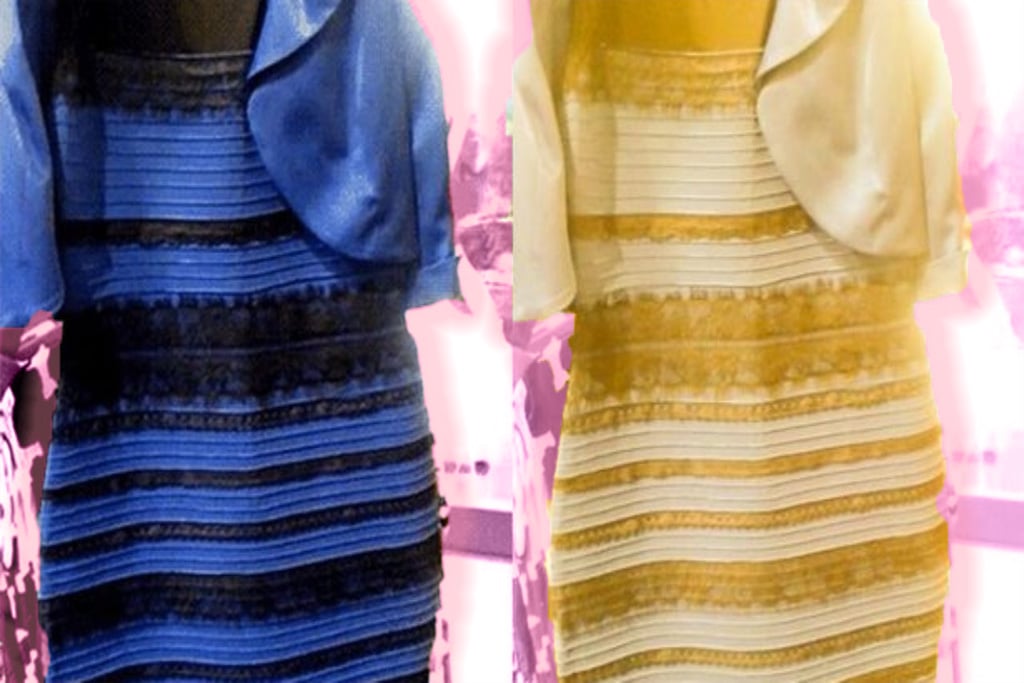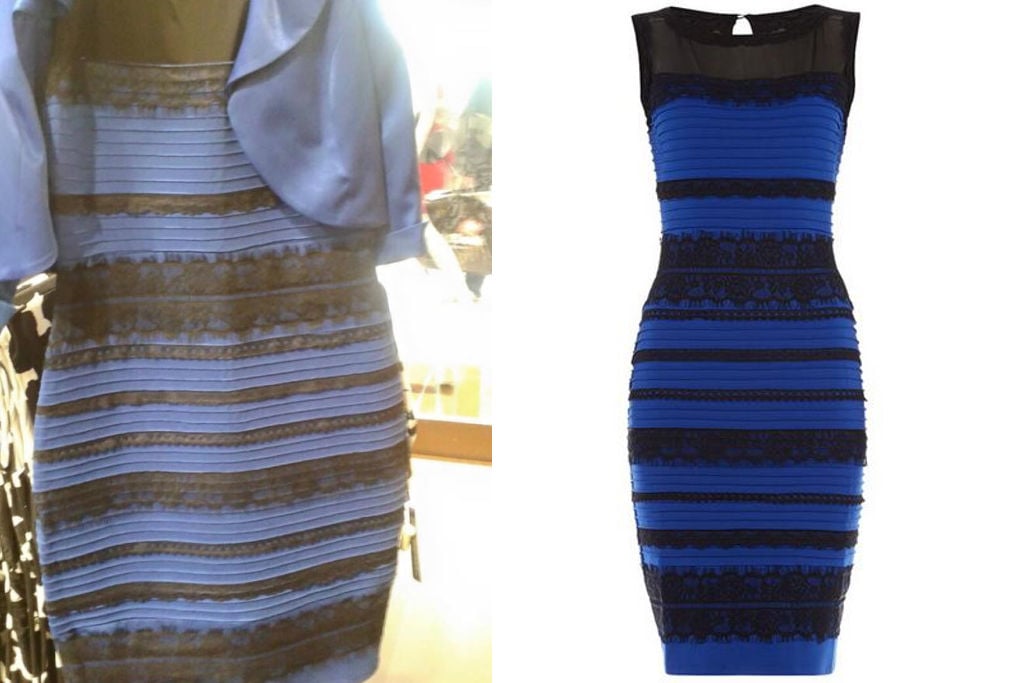The Last Good Moment On The Internet Was When Everyone Lost Their Minds About ‘The Dress’
It's been five years today since the blue and black/ white and gold dress debate.

Time on the internet passes much faster than it does everywhere else.
In but a moment, the most lucrative influencer can be reduced to a sobbing, apology-video generating wreck, and even an appealingly silly viral hit can quickly be deigned irredeemably problematic, as was the case with the iconic Tough Guy Entrance meme which happened to be a very funny video of a very not-funny convicted terrorist who harboured ISIS fugitives.
The constancy and fervour of social media fame means that once something is loved and seen, it must immediately be destroyed. Chewbacca Mom? Cancelled. Ken Bone? Cancelled. “Let people enjoy things!”, you cry — from above, I whisper back, “no”.
In my mind, the last internet thing we could all enjoy together happened exactly five years ago — the rare global meme that caused both fierce debate on either side of an ideological binary, and brought the innately divided social media masses together in the name of brain magic.
I’m talking, of course, about The Dress. The last good internet thing.
It’s been 5 years and Katie kk and I have been arguing over the black blue/ gold white dress. It’s still black & blue.
— Britt 💘 (@BrittneeSue) February 24, 2020
The colour of this dress is tearing my family apart. #whiteandgold pic.twitter.com/uvWxJ1GmBZ
— Colleen Grimes (@collgrimes) February 27, 2015
The Blue Or White & Gold Dress
Not just a dress — the dress that Scottish mother-of-the-bride Cecilia Bleasdale innocently photographed on the 26th of February, 2015.
Bleasdale and her family were amused by an optical illusion in the photo that caused the dress’s colour to change from blue and black to white and gold, depending on the viewer’s perception, and shared the photo to Tumblr (RIP) before the phenomenon got picked up by BuzzFeed, and then the rest of the world.
A follow-up article for BuzzFeed was titled ‘This Dress Is Ruining People’s Lives’, in acknowledgement of the international debate the dress caused in office break-rooms, homes, and Twitter threads everywhere, but that actually couldn’t be further from the truth.
In these divided times, I feel that The Dress was in fact the last time everyone on the internet was yelling at each other in the name of genuine fun. And all it took was some simple caveman brain fuckery to make it all happen.
I will still fight anyone who thinks the dress is white and gold
— chaotic good (@daniivnz) February 23, 2020
Online Science Magic
To refresh your memory, the reason The Dress appears as different colours to different viewers could be due to our brain’s method of processing colour by discounting irrelevant visual information.
Neuroscientists have hypothesised that the colours, strange lighting, and poor quality of the photo have messed with our “chromatic bias of the daylight axis”, causing our monkey brains to alternately dismiss either the cool blue or warm yellow tones of the dress depending on an arbitrary, case-by-case perceptive distinction our minds choose for us.
What’s spooky is that those scientists cannot construct any image to replicate the effect as clearly as it appears in Bleasdale’s photo — The Dress is scientific lightning in a bottle, so of course the internet quickly adopted it as a postmodern mood ring/personality quiz.
The ‘white and gold’ side of the debate consisted of roughly 70% of viewers, and included stars like Katy Perry, Anna Kendrick and Julianne Moore. Meanwhile, the ‘blue and black’ squad were technically more correct, considering Bleasdale confirmed that the dress was blue and black when seen in person — the faction consists of legends like Taylor Swift, Justin Bieber, and me.
Like are you kidding? It’s fucking blue and black!!!! Open your goddamn eyes!!!!!!
We also all knew some whiny bitch who was like “omg you guys it’s actually GREEN and GREY” — Lady Gaga called it “periwinkle and sand”. The dress drama even tore apart marriages, with Kim Kardashian seeing it as white and gold whilst her husband Kanye West saw it as black and blue (maybe he has been chosen by God??).
Then of course, there was a nihilistic party of abstainers to the argument who chose instead to criticise the dowdy design of the dress, which was after all a mother-of-the-bride dress that retailed for fifty pounds.
i’m really still not over the fact that people sat there and said that the dress was white and gold. i really couldnt name something more blue if i tried. god that shit eats away at me. it’s literally fucking blue as shit don’t fucking reply to this tweet
— bhad bhennie (@shinydragonball) February 19, 2020
Simpler Times
Today, a meme that appears to be internationally beloved can still be wrung out for its political implications — take Baby Yoda, a solid contender for Most Wholesome Viral Phenomenon Ever, who has nevertheless been criticised as ‘the logical endpoint of a sinister company with decades of experience at tapping deeply into the human need to nurture something small and charming”.
In an age where a literal billion people can weigh in on pop culture with all their diverse and intersectional life experience as contention, I feel a little nostalgic for a foolish internet argument based on something as childishly simple as what colour information our eyes and brains were receiving.
It’s not like you could pin down the ‘white/gold’ proponents as being misogynistic or something — all potential for a problematic backstory was null and void, since the argument in question was based around such a kindergarten neurological concept.
All of this is not to say that our online lives were better five years ago — they were simpler, sure, but today’s never-ending discussion of how memes represent us can be a valuable opportunity to question just who and what we joke about (another example; sarcastically calling a ‘can I speak to your manager’ busybody type a ‘Karen’ is being challenged for its implicit sexism).
The internet has changed even in the space of five years, and in another five I’m sure it’ll be unrecognisable once again, shaped by whichever voices best speak for (or against) the majority. And that’s great!
Still: The Dress was an unrepeatable existential phenomenon that made us all wonder, if only for a moment, whether seeing really was believing, long before fake news made that prospect too terrifyingly real.
And it did all that while being fucking stupid and good fun. Top that, Baby Yoda.
Eliza Janssen is a writer and editor at Rough Cut, and the host of the podcast Twin Picks with her irritating siblings. To find out more visit @eliza_janssen on Twitter or www.elizajanssen.com.
